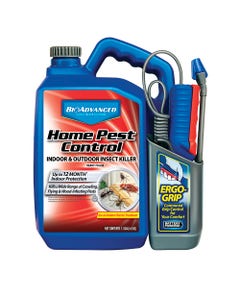

- Home
- Solution Center
- Learn
- Indoor Bugs
- Controlling Roaches
Controlling Roaches
Cockroaches are survivors. They have been active on the planet more than 350 million years, making them one of the oldest living species. They're the No. 1 pest of homes and other structures and are often the first occupant of any new dwelling.
They are well-adapted to living with humans and thrive in the average home. Prepare yourself to fight this unwelcome insect by learning the basics.
Where do they come from?
In all regions, cockroaches can shift from outdoor locations to indoor ones. That's why it's a good idea to block home-invading insects by plugging insect-sized cracks and crevices and tackle other simple steps to keep insects from entering your home. In multi-unit dwellings, they can move from one living space to another by running along utility lines.
What Cockroaches need to survive
Most are tropical and crave warm hiding places, along with access to food and water. Open food containers, dirty dishes, crumbs, grease on the stovetop, water droplets in the sink, leaky pipes and areas with condensation provide adequate food and water supplies for these irritating pests.
German Cockroaches, the most common indoor species, can survive 42 days on water alone. They only survive 12 days without water, even if there's available food.
Where to find them
Central heating allows them to remain active year-round in all climates. During drought episodes, more of them may invade your home in search of water. During flooding, displaced Roaches actively seek out new quarters.
Cockroaches like to hang out in warm, dark, crowded spaces –locations where surfaces touch their bodies, like tiny crevices. Adult German Cockroaches can squeeze into cracks 1/16 inch wide; immature ones hide in even smaller spaces. These insects like corners and tend to travel along edges of surfaces.
In a home, they'll hide in the space behind kitchen drawers, under sinks, behind and in cupboards, and behind and beneath appliances. Outdoors, they may live in meter boxes, sewers and areas with garbage.
They reproduce quickly
One female German Cockroach and her young can produce more than 300,000 offspring in one year. Not every offspring survives; some are even eaten by other Roaches (these are cannibalistic insects). Females lay eggs more frequently during warm weather.
They can cause diseases
They carry bacteria on their bodies, including Salmonella, Streptococcus, and Staphylococcus. They've also been implicated in spreading Hepatitis virus, Typhoid and Dysentery. Because these pests eat anything –including garbage and pet feces –they pick up disease bacteria, which survive in their gut for four weeks or longer. They pass the bacteria in their feces, which other Roaches then walk through and transmit to surfaces in your home.
Roach bodies and excrement are an allergen for some individuals, many of whom develop Asthma. Many urban dwellers (23-60%) acquire Cockroach-Induced Asthma where infestations are severe.
Controlling Cockroaches
The first step in successful control is correctly identifying the type of Cockroach you're fighting. Research online or contact your local Cooperative Extension System office for help in proper identification.
Then eliminate food and water sources. This includes crumbs in the kitchen, leaky pipes or faucets, open pet food containers, etc.
Follow up with insecticides labeled for the type of Roach you have. Treat the exterior of your home with a pesticide perimeter treatment and treat the inside of your home with a product like Home Pest Roach Killer Gel.
If you have a severe infestation or don't know where to start, contact a professional pest control company. Many times, having a pest professional assess the problem and initiate treatments can help jump-start control that you continue yourself. Remember, the longer you wait to handle your infestation, the more of these pests you might have to deal with.















